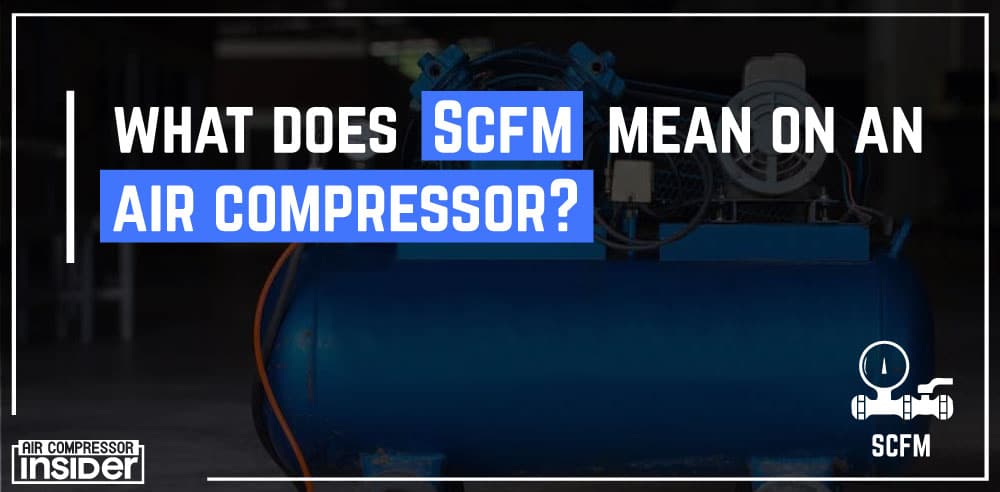What Does Scfm Means?
SCFM, an acronym for “Standard Cubic Feet per Minute,” is a measure used to specify the volumetric flow rate of a gas or air.
In the context of an air compressor, SCFM represents the volume of air that a compressor can supply at a given pressure, typically measured at sea level conditions and a standard temperature, often 60 degrees Fahrenheit.
This measure is critical as it helps users understand the capacity of the compressor, thereby assisting in selecting the appropriate equipment for their specific needs.

- What Does Scfm Means?
- Significance of SCFM in Air Compressors:
- What Does Scfm At 90 PSI Mean?
- What Does 2.6 Scfm 90 PSI Mean?
- What Does 4.0 Scfm Mean On An Air Compressor?
- How To Calculate Scfm Of An Air Compressor?
- Factors That Affect The Scfm Rating Of An Air Compressor:
- The Benefits of Using an Air Compressor with High SCFM Ratings:
- Comparing Different Models of Air Compressors Based on Their SCFM Ratings:
- How to Calculate the Right Size Air Compressor for Your Home or Business Needs:
- Different Types of Pneumatic Tools and How They Impact SCFM Performance:
- Benefits Of Knowing The Scfm Rating Of Your Air Compressor:
- Common Applications For Air Compressors With Different Scfm Ratings:
- Tips For Ensuring You Get The Right Scfm For Your Needs:
Significance of SCFM in Air Compressors:
SCFM (Standard Cubic Feet per Minute) is a key measure in the operation of air compressors, commonly used to quantify the flow rate of air.
This measurement denotes the volume of air produced by the air compressor at a standard condition – typically standardized to a set pressure, temperature, and relative humidity.
Understanding the SCFM output of an air compressor is critical as it impacts the efficiency and compatibility of the device with various tools or applications.
A higher SCFM rating means a more powerful compressor that can support more tools or heavier duty tools simultaneously.
Therefore, when choosing an air compressor, it’s important to consider the SCFM requirement of the tools you plan to use to ensure optimal performance.
SCFM, or Standard Cubic Feet per Minute, is a critical measure in air compressors, denoting the volume of air delivered by the machine under standard atmospheric conditions.
A higher SCFM rating indicates a more powerful compressor capable of operating multiple tools or larger equipment concurrently.
Understanding your air tool’s SCFM requirements and ensuring they align with your compressor’s capacity is essential to achieve optimal performance and longevity of your equipment.
What Does Scfm At 90 PSI Mean?
SCFM, or Standard Cubic Feet per Minute, at 90 PSI refers to the volume of air in cubic feet that a compressor can supply at a pressure of 90 pounds per square inch (PSI).
This measure is standardized to a set of “standard” conditions which typically include a set temperature and pressure, allowing for easier comparison between different compressors or systems.
The higher the SCFM at a specific PSI, the more air volume the compressor can deliver at that pressure.
This is a crucial specification when selecting a compressor for tools and applications that require a certain volume of air at a specific pressure to operate effectively.
What Does 2.6 Scfm 90 PSI Mean?
The term “2.6 SCFM at 90 PSI” is often seen on air compressor specifications and it refers to the airflow or volume output of the compressor.
Here, SCFM stands for Standard Cubic Feet per Minute, which is a measure of air flow rate.
It indicates how much air the compressor can produce per minute at a standardized condition, typically at sea level with 68°F air at 36% relative humidity.
The “90 PSI” stands for pounds per square inch, a unit of pressure. This means the compressor can maintain an airflow of 2.6 SCFM at a pressure of 90 PSI.
It’s an important specification to consider when you need to match an air tool’s air consumption requirements with the capability of a compressor.
It means that the compressor can deliver a steady 2.6 SCFM of air, while maintaining a pressure of 90 PSI.
Thus, the tool you are driving should require less than or equal to 2.6 SCFM at 90 PSI to operate effectively.
What Does 4.0 Scfm Mean On An Air Compressor?
4.0 SCFM (Standard Cubic Feet per Minute) on an air compressor refers to the volume of air that the compressor can supply per minute at standard atmospheric conditions.
This measure is crucial as it indicates the compressor’s capacity and determines the types of tools and applications it can support.
A 4.0 SCFM rating suggests that the compressor can supply a consistent airflow of 4 cubic feet per minute at a standard pressure, suitable for powering a range of small to medium-sized air tools.
It’s important to match the SCFM of your compressor with the needs of your air tools for optimal performance.
How To Calculate Scfm Of An Air Compressor?

To calculate SCFM (Standard Cubic Feet per Minute) on an air compressor, you’ll need to know the machine’s PSI (Pounds per Square Inch), CFM (Cubic Feet per Minute), and the standard atmospheric pressure.
Here are the steps to follow:
1. First, find the machine’s PSI and CFM ratings. These are typically stated in the user manual or on the compressor’s nameplate.
2. Next, use the formula: SCFM = CFM x (Pactual / Pstandard), where Pactual is the actual pressure and Pstandard is the standard atmospheric pressure, which is approximated to 14.5 PSI.
3. Substitute the values you’ve obtained from the compressor into the formula to get the SCFM.
Remember, this calculation gives you the SCFM at the current atmospheric pressure. Hence, it might vary with changes in weather and altitude.
Factors That Affect The Scfm Rating Of An Air Compressor:
Main factor that affects the SCFM (Standard Cubic Feet per Minute) rating of an air compressor are as under:
1. Engine Power:
The engine power of the compressor will be a major factor in determining its SCFM rating. Generally speaking, higher powered engines will provide more air flow than lower powered ones.
2. Air Tank Size:
A larger tank size allows for increased air pressure and can improve the SCFM rating of a compressor. This is because a larger tank size will allow more air to be stored, thus providing more pressure and a higher SCFM rating.
3. Compressor Technology:
The type of compressor technology used can also affect the SCFM rating. Newer technologies such as oil-free models or rotary screw compressors are typically more efficient than traditional piston ones, resulting in better SCFM ratings.
4. Ambient Temperature:
The ambient temperature of the surrounding air can have an impact on SCFM ratings. Extreme temperatures, whether hot or cold, can affect the air pressure and thus reduce the SCFM rating.
5. Altitude:
Higher altitudes provide less oxygen in the atmosphere, which can lower a compressor’s SCFM rating. This is because there is not as much air pressure at higher elevations.
6. Compressor Type:
The type of compressor being used can also affect the SCFM rating. Portable and stationary compressors may have different ratings due to their design features.
7. Filters and Accessories:
Filters, mufflers or other accessories installed on the compressor can reduce air flow and decrease its SCFM rating. These should be checked and replaced if necessary to ensure maximum air flow.
8. Maintenance:
Consistent maintenance on the compressor can help maintain its SCFM rating. Regularly replacing filters, checking for leaks and keeping all parts lubricated are key steps to ensuring that your compressor is working at its peak performance.
It is important to understand all of these factors in order to determine the best SCFM rating for your compressor.
When shopping for a compressor, consider all of these factors and make sure to select one that meets your needs.
Additionally, be sure to follow proper air compressor maintenance procedures in order to keep your compressor running at its highest efficiency and ensure you get the most out of it.
The Benefits of Using an Air Compressor with High SCFM Ratings:

Air compressors with high SCFM (Standard Cubic Feet per Minute) ratings bring forth several benefits.
Firstly, they offer more power and efficiency, making them ideal for tasks requiring high energy such as power-washing, spray painting, or running heavy machinery.
Secondly, high SCFM compressors can operate multiple tools simultaneously, optimizing workflow and productivity in industrial settings.
Lastly, these compressors tend to be more durable and reliable, reducing downtime due to maintenance or repairs.
Thus, investing in an air compressor with a high SCFM rating can streamline operations and yield long-term cost savings.
Comparing Different Models of Air Compressors Based on Their SCFM Ratings:
When choosing an air compressor, one key metric to consider is the Standard Cubic Feet per Minute (SCFM), which measures the volume of air flow.
For instance, the Porter-Cable C2002 delivers an SCFM of 2.6 at 90 PSI, making it suitable for light-duty tasks such as inflating tires or running a brad nailer.
On the other hand, the Makita MAC2400 boasts a higher SCFM rating of 4.8 at 90 PSI, suggesting it can power more demanding tools like impact wrenches.
Comparatively, the DeWalt D55146 stands out with an impressive SCFM of 5.2 at 90 PSI, indicating it has the capability to run multiple heavy-duty tools simultaneously.
Always remember to match your tools’ SCFM requirements with the air compressor’s SCFM output for optimal performance.
How to Calculate the Right Size Air Compressor for Your Home or Business Needs:

Calculating the right size air compressor for your home or business needs can be done in several steps.
First, identify what tools or appliances will be using the compressor and their cubic feet per minute (CFM) requirements.
The CFM represents the air volume a tool requires to operate. Second, consider the duty cycle of the compressor.
This is the amount of time the compressor can run before it needs to rest. For heavier usage, a compressor with a high duty cycle is necessary.
Third, consider the power source. If you’re using the compressor in a place with limited or no electricity, you might need a gas-powered model.
Finally, consider the tank size. The tank size determines how long air tools can run before the compressor turns back on.
Remember, larger tanks don’t necessarily provide more pressure, they simply store more air.
By considering these factors, you can accurately calculate the right air compressor size to meet your needs.
Different Types of Pneumatic Tools and How They Impact SCFM Performance:

Pneumatic tools, also known as air tools, operate through pressurized gas, commonly air.
They are versatile and powerful tools, with various types meeting a wide array of industrial and home-use needs.
The three broad categories of pneumatic tools are:
1. Rotary tools
2. Reciprocating tools
3. Linear tools.
1. Rotary tools:
Rotary tools are powered by the torque created through spinning motion.
They include drills, grinders and sanders. SCFM (Standard Cubic Feet per Minute) performance is particularly important in rotary tools, such as those used for drilling.
To get optimal performance from a pneumatic drill requires adequate air pressure and air volume to power it.
2. Reciprocating tools:
Reciprocating tools are powered by the stroke motion created when a piston moves back and forth in a cylinder.
These include nailers, staplers and saws. SCFM performance is important for these types of tools too, as they need adequate air pressure to power their functions.
3. Linear tools:
Linear tools are powered by the movement of non-rotating, linear pistons.
Examples of this type of pneumatic tool include nut runners and jackhammers. SCFM performance is also critical for these tools; they need enough air pressure to power their motion.
The performance of these tools is directly impacted by the Standard Cubic Feet per Minute (SCFM), which measures the volume of air required by the tool to operate efficiently.
Each tool has a specific SCFM rating, and understanding this can significantly influence the effectiveness and longevity of the tool.
The higher the SCFM, the more air the tool uses, and the more powerful it is.
Therefore, when choosing an air compressor to power these tools, it is critical to ensure its maximum SCFM rating is compatible with the tool’s requirement to ensure optimal performance.
Benefits Of Knowing The Scfm Rating Of Your Air Compressor:
Understanding the SCFM (Standard Cubic Feet per Minute) rating of your air compressor is crucial in ensuring its efficiency and longevity.
This rating is a key indicator of the compressor’s performance, determining its capacity to power various tools.
A higher SCFM rating generally corresponds to a more powerful compressor, capable of delivering more air pressure and operating larger equipment.
Conversely, a lower SCFM rating may be sufficient for smaller, less power-intensive tools.
By knowing the SCFM rating of your air compressor, you can better match your equipment to your project needs, avoid unnecessary wear and tear on the compressor, and ultimately save on energy costs.
Common Applications For Air Compressors With Different Scfm Ratings:
Air compressors with different SCFM (Standard Cubic Feet per Minute) ratings are utilized across a vast range of applications, each suited to specific workloads and requirements.
Low SCFM:
Low SCFM compressors (under 10 SCFM), for instance, are ideal for tasks such as inflating tires, powering pneumatic nail guns, or operating airbrushes, where the demand for volume is relatively low.
Medium SCFM:
Medium SCFM compressors (10-30 SCFM) are commonly used in automotive workshops for tasks like operating impact wrenches or sandblasters, which need a consistently high volume of air over a sustained period.
High SCFM:
High SCFM compressors (30 SCFM and above) are typically found in industrial applications like manufacturing, where they may be used to drive heavy machinery, in large-scale painting operations, or in HVAC systems.
Please note that these are general categorizations, and the appropriate compressor for a specific task depends on a combination of factors, including not just SCFM, but also PSI (pounds per square inch) requirements, duty cycle, and the environment in which the compressor will be used.
Tips For Ensuring You Get The Right Scfm For Your Needs:
Here are some key tips to ensure you get the right SCFM (Standard Cubic Feet per Minute) for your needs:
1. Understand Your Requirements:
The first step to getting the right SCFM is understanding the needs of your application. Consider the air pressure and volume demands of your devices or machinery.
2. Evaluate Your Equipment:
Every pneumatic device should have a rated SCFM at a set pressure. Add up the SCFM of all the equipment that may run simultaneously to determine your total demand.
3. Consider Future Needs:
When choosing a system, think about your future requirements. It’s advisable to choose a system with an SCFM rating 20-30% higher than your current demand to accommodate growth.
4. Check Compressor Efficiency:
Not all compressors are 100% efficient. Always check the efficiency rating and factor this into your calculations.
5. Seek Professional Advice:
If you are not sure about your SCFM requirements, consider consulting with a professional. They can help assess your needs and recommend suitable equipment.
6. Test Your System:
Once your system is installed, make sure you regularly test it to ensure the SCFM rating meets or exceeds your needs.
7. Review Your Requirements Periodically:
Over time, the requirements of your application may change. Regularly review your system and adjust the SCFM as needed to meet your new demands.
These tips can help you make an informed decision that ensures your system is always equipped with the right SCFM for your needs.
Additionally, by regularly testing and reviewing your requirements, you can ensure the longevity of your system and avoid any unexpected breakdowns or malfunctions.
Regular maintenance and testing also helps to reduce energy costs and ensure optimal performance.
